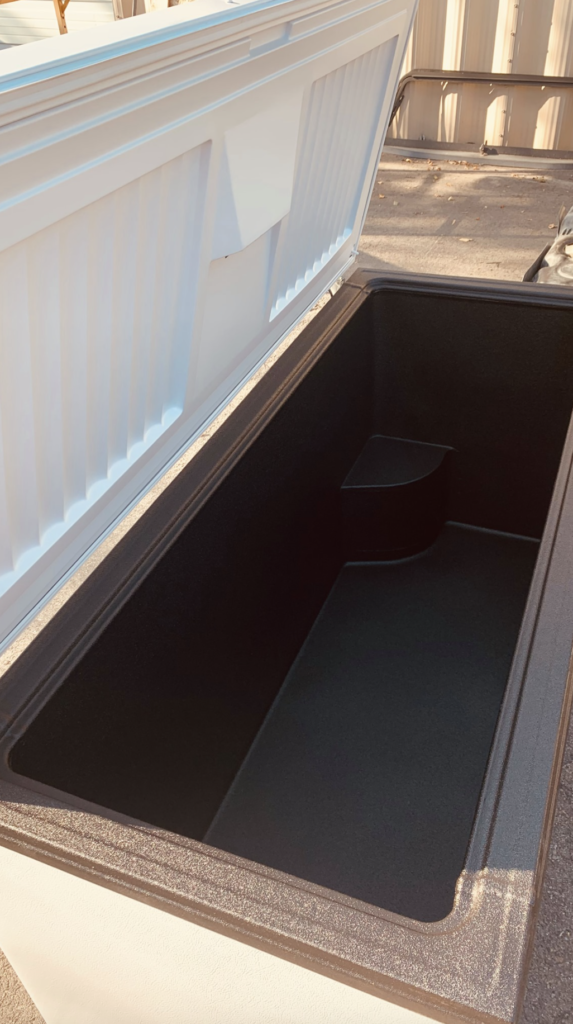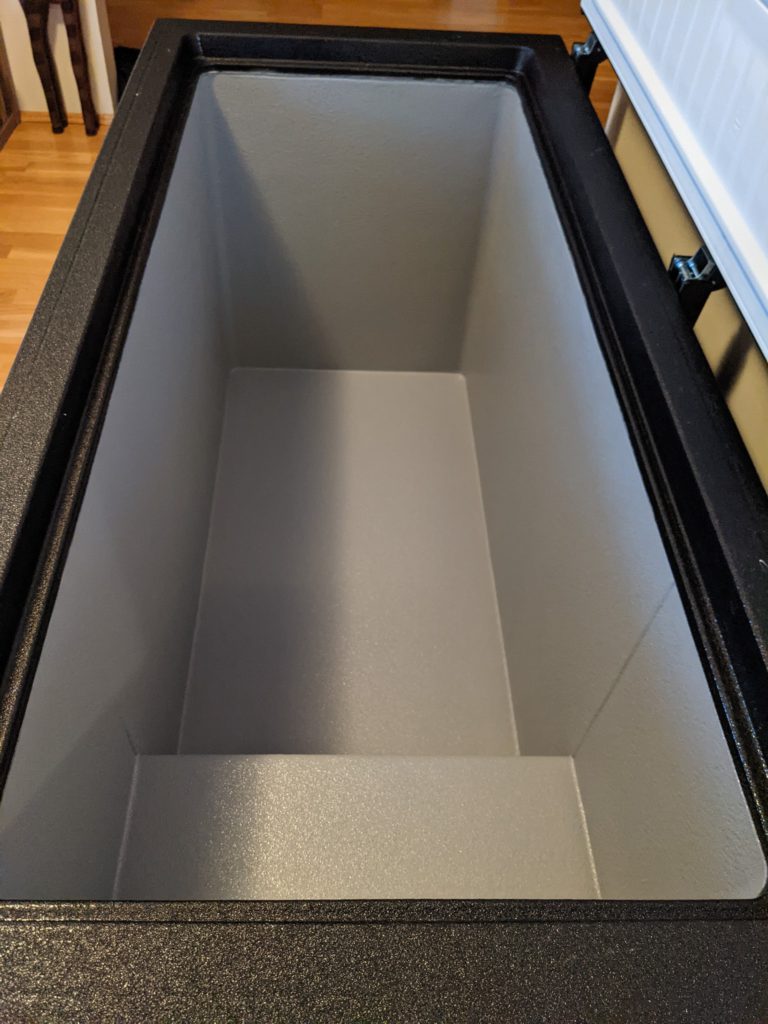Line-X Best Practices for a Chest Freezer Cold Plunge
This post will cover the most common questions and concerns about applying Line-X to a chest freezer to be used as a cold plunge and will answer most if not all of the questions that people have.
Disclaimer
I have no financial arrangements with the Line-X company, any of their stores, or franchises.
Does My Chest Freezer Need a Liner?
It is a best practice to apply a liner to chest freezers with both bare metal interiors and white enamel interiors. A liner protects the chest freezer from damage, rust, and corrosion.
Line-X is one of the four recommended liner options. The other three are:
1. Pond Shield (DIY)
See this link for more info
Pond Shield – 7 Steps to Success!
2. Pond Liners
3. Custom Removable Liner
https://chestfreezercoldplunge.com/custom-linersSee here for more information
Is it Safe
All four of the liner options that I recommend are VOC-free after curing and do not leach chemicals into the water. There are three safety standards: potable water, fish/aquarium use, and pools and spas.
Line-X XS-350 is certified safe to be used for potable water (you can drink out of it), so yes, is it safe to soak in the water it hold. That said, I don’t recommend drinking your cold plunge water. 😉
Other brands and formulations of spray liners are available. Check with the dealer before you proceed. If it it not
– suitable for long-term submersion (water containment), AND
– suitable for potable water
I recommend avoiding it.
Basic Line-X Details
Material
- XS-350 is the best practice.
- XS-100: Use at your own risk and only if you can’t find a shop that applies XS-350. XS-100 will not last as long. Most issues (by far) reported have been XS-100.
- Top Coat – yes or no?: It depends on your preference. It is easier to clean with the top coat. Some technicians have said it will likely crack, not hold up long-term in cold water, and would not offer a warranty if the top coat was applied.
- Correct prep work is essential.
Additional Notes about XS-350 vs. XS-100
In my early research on this topic, I spoke with a chemist at Line-X, the corporate trainer, and several experienced Line-X shop owners. They all recommend XS-350. XS-350, which is used for industrial containment systems and for municipal potable water supplies.
None of the people I talked with had a solid answer about the longevity of XS-100 when used for chest freezer cold plunges. However, all of them said that XS-100 would peel off over time with constant exposure to water.
Do you want some guesses? I was told XS -100 could last a few years or one maybe 8 to 10 years. Again, nobody knows for certain. The oldest XS-100 applications I know of for chest freezers are a little over 2 years old.
The only shops saying that XS-100 is perfectly fine are the shops that offer only XS-100.
We are very certain that XS-350 will outlast the chest freezer- if the correct prep work was done.
Prep Work
The best practice is to have the shop do 100% of the prep work.
- Sand the entire area where Line-X is to be applied, including the top plastic trim.
- Seal all seams, including the drain inside (needs to be 100% watertight)
- Sealant:
- Best Practice: Polyurea caulk or urethane
- OK: whatever other material the shop uses, including standard caulk.
- AVOID: silicone or any product that cures via moisture
Application Area
- Apply Line-X to the entire inside, top plastic trim (inside and out), and approximately 1” down the outer walls
- Over the drain inside the chest freezer. It’s OK to remove the drain plug if you don’t want it sticking up from the floor, however, the hole should be filled with something solid that will stay in place. A 2-part epoxy putty such as JB Water Weld will work. The drain should be sealed on the inside of the chest freezer only. Do not seal the outside of the drain- it acts as leak detector. Yes, the drain will no longer work. Use a transfer pump with a hose a submersible utility pump, or siphon to empty the water when needed.

- Outside walls and lid: Optional, but can be done. It will not interfere with the chest freezer working. The plastic vents can be coated or left uncoated, but if coated, they must be removed to avoid any Line-X getting into the mechanic’s area.

- Outside bottom: Optional but can be done.
- Lid (inside and out) – OK, but see the warning in the Application tips below.

Do NOT Apply Line-X To These Areas
The following areas should be masked and should not have any Line-X applied:
- The back of the chest freezer body where the hinges attach. If the lid is left on during application, just have them spray around the hinges. If the lid is removed for the application, the areas where the hinges attach to the back of the chest freezer must be masked.
- Do not have Line-X applied on any of the equipment inside the mechanic’s area, and do not let it block any vents on the bottom, sides, or back.
- Any place where power cords or wires attach should be avoided.
Color
Black is standard. Some shops (typically those that apply LX to boats) have white at the same price. Custom colors may be available, but can increase the price by 50% – 200%. Different colors can be used.

Warranty
At the shop’s discretion. Can range from no warranty at all to 1 year or a lifetime.
Price
Pricing can vary greatly depending on what kind of shop it is, where it’s located, how busy they are, and a number of other variables. For the interior/top trim area of a 15 cu ft / 400 L chest freezer, prices for XS-350 can range from $500 to $1,500.
XS-100 is typically priced much lower, but again- there is a risk in not knowing how long it will last.
Dimensions
The shop may or may not care about the exact dimensions. Usually, they want to know the approximate square feet of your chest freezer, which you can figure out by measuring it.
Pictures
They usually want to see it in person before agreeing to the work. However, some shops are OK with you sending pictures. Send them a 3/4 view and an interior view of your chest freezer.
Here are examples:


Approaching the Shop
Keep it simple. Do not overwhelm them with details.
Make it easy for them to say yes.
Here is what I typically say when calling Line-X shops for my clients:
“I have friends in other states who had their Line-X shop coat the inside of a chest freezer to make a cold plunge, and it’s been working great. Is that something you could do for me?”
If an employee says “No,” ask if you could chat with the manager or owner of the shop.
Application Tips
1. Have the shop do 100% of the prep work. Including sealing the seams. Do NOT seal the seams yourself. If something goes wrong (ex. leaking), the shop should fix it at their cost. Be sure to talk with them about what happens if it leaks.
2. According to Line-X corporate and some techs I have talked with, the seams MUST be sealed before applying Line-X because Line-X is a coating, not a gap filler. The best practice is to use a polyurea or pure urethane caulk. Some shops will only use standard caulk, which seems to be working so far. Do *not* use silicone or any kind of caulk that requires moisture to cure.
Because it takes too long, the shop will not be interested in using 2-part epoxy putty- like JB Water Weld (JBWW) to seal the seams, so don’t ask. It really is overkill anyway because of how durable Line-X is.
Do you want to seal the seams with JBWW before you bring your chest freezer to the shop? If you have already done it before reading this, just make sure it is 100% solid and applied everywhere it needs to be. If you have not yet applied JBWW, don’t do it! See #1 above.
3. If Line-X is applied to the lid (inside or out) tell them not to apply too thick of a coating because it might add too much weight for the hinges to hold it open. Ask them not to go too heavy on the upper trim, because it could prevent your lid from closing correctly. If you have hinges that are adjustable, a standard application thickness will be OK. You can tell if your hinges are adjustable because the holes where the screws attach to the body will have a vertical groove rather than just a round hole.

If too much Line-X is applied to the lid, the hinges may not be able to hold the lid open. If that happens, you will need to find another way to keep the lid open. Two solutions: you can use a board to prop it open from the front or use a chain attached to the wall and to an eye hook in the lid.


4. Ask them not to go too heavy on the upper trim, because it could prevent your lid from closing correctly. If you have hinges that are adjustable, a standard application thickness will be OK. You can tell if your hinges are adjustable because the holes where the screws attach to the body will have a vertical groove rather than just a round hole.
Warranties
It is completely up to the discretion of the shop owner if they will warranty the work or not. Most will not.
However, if the shop does all of the best practice prep work (including sealing the seams) for you and it leaks, they should take care of it at no additional cost. Work this out with the shop BEFORE you have the work done.
Fixing a leak (if the seams were sealed) usually means applying additional Line-X. It could mean sealing the seams and applying more Line-X.
If the shop used XS-100 and it leaks down the road because the product is peeling, flaking, or otherwise failing, applying more Line-X will not help.
Line-X Competitors
If you don’t have a Line-X shop near you that can do the work, you can reach out to their competitors. Rhino is one company that some people in our community have used. There are others, but I don’t have any feedback about them. Ask for the product that is the closest to XS-350. The best practices on this page apply. We have a few good reports about Rhino, but also quite a few problems, most likely from insufficient prep work and/or using the wrong product. Generally speaking, the reports we have seem to indicate that the technicians shops who offer Line-X XS-350 are the best trained and most knowledgeable.
DIY Spray Liners
You can buy truck bed spray liners in a can. Raptor is one such product. On paper, the manufacturer answered all of my questions about it being suitable for use in a cold plunge. In practice, however, even with meticulous prep work, we have a very high failure rate reported within a very short period of time (a few weeks to a few months). Because of that, I do not recommend using Raptor for your cold plunge.
What about Flex Seal? Don’t even think about it! It has a 100% reported failure rate.
If you want to go the DIY route, check out Pond Shield. The link is at the top of this article.
